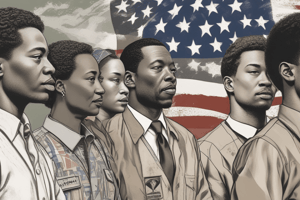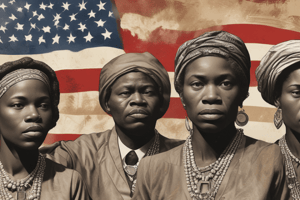Podcast
Questions and Answers
The civil rights movement of the 1920s aimed to bring about equality and justice for Hispanic Americans.
The civil rights movement of the 1920s aimed to bring about equality and justice for Hispanic Americans.
False (B)
The National Association for the Advancement of Colored People (NAACP) was founded in 1909.
The National Association for the Advancement of Colored People (NAACP) was founded in 1909.
True (A)
The Urban League was established in 1921 to promote economic opportunities for Native Americans.
The Urban League was established in 1921 to promote economic opportunities for Native Americans.
False (B)
The Buchanan v. Warley case of 1917 upheld racially restrictive housing covenants in Kentucky.
The Buchanan v. Warley case of 1917 upheld racially restrictive housing covenants in Kentucky.
The Smith-Hughes Act of 1917 provided federal funding for vocational education programs.
The Smith-Hughes Act of 1917 provided federal funding for vocational education programs.
The Gaines v. Canada ruling required states to provide segregated educational facilities for students.
The Gaines v. Canada ruling required states to provide segregated educational facilities for students.
Study Notes
Social Movements of the 1920s
The 1920s were marked by significant social upheaval as various movements challenged the status quo and sought to improve the lives of marginalized communities. Among these was the civil rights movement, which aimed to bring about equality and justice for African Americans.
Civil Rights Movement
The civil rights movement of the 1920s emerged from the efforts of organizations such as the National Association for the Advancement of Colored People (NAACP), founded in 1909, and the Urban League, established in 1911. These groups worked towards ending racial segregation, achieving voting rights, and promoting economic opportunities for Black Americans.
Legal Challenges
During this period, several legal challenges were mounted against discriminatory practices. One notable case was Buchanan v. Warley (1917), which struck down racially restrictive housing covenants in Kentucky. In another landmark decision, the 1923 Gaines v. Canada ruling required states to provide equal educational facilities for students without undue hardship.
Education Reforms
Educational reforms also played a crucial role in the civil rights movement of the 1920s. For instance, the Smith-Hughes Act of 1917 provided federal funding for vocational education programs. This act led to the establishment of schools focused on practical skills training for children.
In summary, the 1920s saw the emergence of several social movements, with the civil rights movement being one of the most prominent. Through legal challenges, educational reforms, and activism, these movements sought to challenge discrimination and inequality, laying the groundwork for future civil rights advances.
Studying That Suits You
Use AI to generate personalized quizzes and flashcards to suit your learning preferences.
Description
Explore the significant social movements of the 1920s, focusing on the civil rights movement that aimed to achieve equality and justice for African Americans. Learn about legal challenges, educational reforms, and the impact of organizations like the NAACP and the Urban League.




